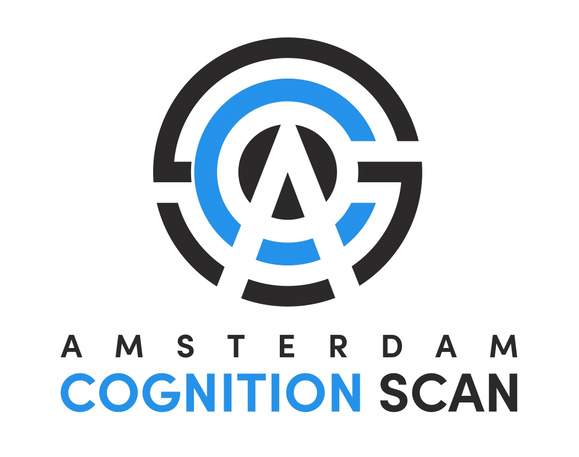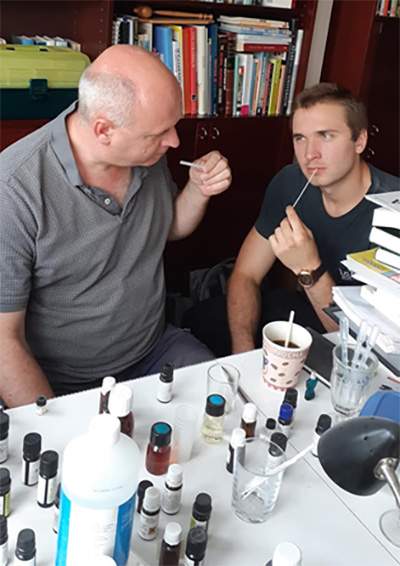- Name: Jaap Murre
- Number of lab members or colleagues (excluding PI): About 70 in the Brain & Cognition Group but I am working closely with only a dozen or so.
- Location: University of Amsterdam
- Graduation Date: Ph.D. in 1992
- H index: 34
- Grants: Fellowships of the Netherlands Royal Society, large PIONIER Grant by the Dutch Research Council and a whole bunch of smaller ones.
- Success lab’s members: Some of them have gone on to become full or associate professors or Principal Investigators in leading institutes.
- Twitter followers: 27 (I have only written 2 tweets though, so there is room for growth!)
I am a full professor and the leader of the Brain and Cognition Group at the University of Amsterdam, where I have worked since 1995. It is a very nice place to work and do research, with excellent facilities and great colleagues. Before that, I did a three-year postdoc in Cambridge (England). My Ph.D. at Leiden University was on neural network models of learning and memory, a topic that I have pursued in various ways since then.
What’s your backstory and how did you come up with the idea?
Since my undergraduate studies, I have been fascinated with human memory. How plastic is the brain? How do we learn and how do we forget? Doing long-term memory experiments has one large drawback compared with say perception experiments: Subjects need to come back after some time so we can see what they still know. This is perhaps why the great majority of memory experiments have timescales of less than an hour as they have been done with university students for a one-hour credit. To get around the one-hour limitation and to get a more diverse population, we were one of the first in the world to move some of our studies to the Internet. Our website http://memory.uva.nl has been running experiments since 2000! Via the Internet it is much easier to get people to come back after say a week or so. In the past few years, we have moved the scripting of Internet-based experiments to a company (see https://scripting.neurotask.com) to help other researchers develop reliable online experiments.
In the course of my studies, I discovered I really like programming and building models. I am one of the few senior scientists I know who still does most of his own programming. Developing systems for online experimenting and testing is therefore a good fit for me.

Please describe the process of learning, iterating, and creating the project.
Memory research has a long history, with the German psychologist Hermann Ebbinghaus being credited of having charted the first forgetting curve back in 1885. By using himself as a subject, he spent months learning and relearning nonsense syllables until he could tell in some detail how memory fades over time. I had been teaching about this classic work for years but never seen a replication. Perhaps, he made it up. Perhaps, he was such a genius that his memory was far superior and the curve does not apply to us. Turns out neither is true (well, he was still a genius I think) as we did a fairly complete replication, with one of my students, Joeri Dros, spending 70 hours learning nonsense syllables (see the freely accessible paper at https://journals.plos.org/plosone/article?id=10.1371/journal.pone.0120644 ).
This is an example of a very labor-intensive project that involves just one subject. At the other extreme we replicated another classic experiment that was first done by the multi-talented British scientist Francis Galton, also in the nineteenth century. He drew up a list of simple words, like ‘cup’ and ‘flower’, and then tried to use these to evoke personal memories. He was most interested in which periods of his own life would have most memories. Later work showed that there is a so-called ‘reminiscence bump’ in human memory with most memories of our own life being from between 10 and 30 years of age. Using the Internet, we could replicate Galton’s original experiment, but now with 2000 subjects rather than just one. This gave very detailed data and confirmed existing work.
Once we were familiar with Internet-based psychological experiments, we branched out to online neuropsychological testing. We created a test battery that contains a number of popular neuropsychological tests, often used to assess brain damage in patients. These tests are administered by trained neuropsychologists in a clinical setting. Our challenge was to translate both the tests and the setting to the situation of a patient at home behind a computer screen and without a neuropsychologist. We were aware that not all patients can be tested in that manner but a large percentage has only mild impairments. After several years of iterating the tests and validating with different groups of subjects, we finally arrived at a good-enough version that we felt confident to share with the world: The Amsterdam Cognition Scan (see for details https://pure.uva.nl/ws/files/29279990/Chapter_3.pdf and https://www.cognitionscan.org/).

Please describe the process of launching your project
Another study that uses the Internet was quite different from the ones above. Here, we wanted to provide a platform where clinicians could enter the raw scores that patients achieved on neuropsychological tests (including for example IQ tests). Our online system was aimed to give high quality indicators of how ‘abnormal’ the patient’s scores were. For this project, we compiled a database with test scores from over 24,000 healthy Dutch subjects. These data originated from colleagues in the Netherlands and Belgium and needed to be sorted and normalized, which was very time consuming. Our team also developed sophisticated models to analyze the data.
One completely new aspect was that for the first time, we could offer indications of abnormality not just of individual tests but also about test profiles. For example, if a patient had bad attention and also bad memory we could very precisely assess the probability that this specific combined score was abnormal. We can currently go up to 15 simultaneous tests and are working to extend this.
To test our system, we verified whether it would help to predict whether people with mild cognitive impairments will go on to get Alzheimer’s or Parkinson’s Dementia. And indeed, by simply using our system instead of the standard norms that come with each test, we could improve the predictions significantly. For more information see the project website: https://andi.nl.
Since launch, what has worked to make your project grow/be successful?
Our goal with the latter project was to provide a tool for clinicians that would give superior results with more precise assessments of patients’ cognitive health. The project grant included funds to develop a website to provide this for the clinical community. We found, however, that it takes much more effort to satisfy online ‘customers’ than an academically constructed system. The clinicians want different features, more tests, better usability, better documentation etc. Also, the funds did not provide for the long-term maintenance of the website and we wanted this to be something that lasts for years, decades even. We, therefore, decided to spin-off a commercial enterprise as these goals do not fit those of a university (though the University of Amsterdam was very helpful in setting up the company).
We got additional grants to commercialize our academic system. This allowed us to extend the website and platform in ways the customers had told us. The platform is now operational at https://andinorms.nl. It is only available for Dutch neuropsychological tests (though the site supports English too).
How is everything going nowadays, and what are your plans for the future?
I would like to improve the way neuropsychological testing is done at the moment in several ways. (1) Make our own test platform more widely available, in other languages, and in other areas (e.g., sport psychology). (2) Develop neuropsychological tests that you can use many times with a single patient. This is usually impossible now. Take an IQ test: once you have taken it, you will have figured out some of the problems. Next time you take it, you will be much faster and further and your IQ will appear higher. What you need is an IQ test (and other types of tests too) with an ‘infinite’ number of items. This can be done by generating them on the fly on the basis of well-understood algorithms. This is the subject of new research we are developing. Follow it via https://myiq.science/. (3) I would like for this new generation of tests to be freely available (Open Source, Open Access), both the programming code to run them (online) and the norms that drive the assessments. In that way, IQ testing will be easily available to researchers world-wide (currently it is expensive to test IQ as part of research). More, generally, neuropsychological testing will be made available for free in countries that currently lack a good neuropsychological infrastructure. (4) I would like to use Machine Learning (deep learning) to do a more encompassing analysis of existing data (including our own), thus, extracting more information, allowing even better assessments and predictions.
From the above, it may seem that I am mostly doing neuropsychology and online testing. This is not true. One project I am very excited about is one where we compile a large database of very detailed neuroanatomical data about the memory and emotion centers in the brain (called hippocampus and amygdala, resp.). This database is already partially available online (see https://www.temporal-lobe.com/). We will use this to develop an anatomically detailed neural network model of learning and (emotional) memory. Our goal is to gain more insight into the how and why of the intricate connections of the memory areas of the brain and to better understand the patterns of memory loss that occur in for example Alzheimer’s Dementia. The platform for the neural network simulations is largely finished and will also be available online (Open Source). We are currently trying to secure additional funding for this while the research continues at a slower pace.
Through your science, have you learned anything particularly helpful or advantageous?
One of things I have learned is that you can feel very sure something is going to work, only to find it actually does not. That is why we do research in the first place of course. This was most evident to me in our recent large-scale study of online brain training, which lasted over five years and involved stroke patients and seniors. We were planning on (among others) developing a tailored online brain training platform as an additional therapy for recovering stroke patients but instead found a null effect. Despite a large number of patients and thorough training (3 months, 30 min per day), there was no added benefit of online brain training. See for example our freely accessible study at PLOS ONE: https://journals.plos.org/plosone/article?id=10.1371/journal.pone.0172993.
Another lesson is that you often have to be very persistent and patient. It may take a year or more to secure a grant. Many times you do not get the funding (some grants have less than 10% chance). Setting up a good study takes a lot of time with many choices to make. Once you have collected the data and written and submitted your paper, it may take many months before you hear anything from the journal. Multiple rejections and resubmissions are quite common. My most cited paper (on a theory of rehabilitation from brain damage, with collaborator Ian Robertson) was rejected several times, requiring significant rewrites. It was a long paper and we reached a point where the subject line of our email message about it was simply ‘Damn paper’.
Finally, and this is something that each researcher will have to figure out individually, I decided that I really like the hands-on work of developing a model or experiment. At some point, I had a large research group and everybody was having fun doing the work, whereas I found myself mainly working ‘indirectly’: giving advice and discussing results etc. I did not like doing only that. I missed doing the actual work. So, I now try to keep a middle ground between having a few Ph.D. students but leaving enough time for my own work. I know I will produce fewer papers (etc.) that way, but I prefer it anyway.
We would be glad to know more about you. What is your morning routine like?
I am an extreme evening person and hate to rise before 10am. Then, I have a light breakfast with two large mugs of strong coffee while reading the news and then my email. I usually try to get most of my ‘busy work’ out of the way then.
How does a typical day look for you?
The afternoon I have a few meetings (online nowadays) or give a lecture followed by some more concentrated work. In the evening, I usually work more between say 11pm and 2am. No emails coming in, no distractions. That’s when I do my best creative work.
And what does your workstation look like?
I work on a souped up gaming PC. I never play games but I like the power it gives for heavy computing (e.g., for neural network simulations). About five years ago, I decided to become ‘paperless’, so I read papers onscreen or on my 13inch ereader, which also allows me to highlight text etc. Everything is synchronized to the cloud.
One of the things I started doing last year is to close Gmail once I am done with all my messages. I will check it once or twice during the afternoon, but I no longer have the distracting habit of ‘seeing whether there is anything new on Gmail whenever my attention to the task at hand lapses.
Which platform/tools do you use for your professional life?
I use good-old-Excel for many things, business and academic, including not too complex statistics (e.g., analysis of variance). It has the great advantage that you see exactly what is going on, without mysterious behind-the-scenes calculations. It also has a great Solver, which almost nobody seems to use, but which is very powerful. For more powerful analyses, I use Mathematica: truly awesome software with somewhat scary analytic power.
What secondary software and apps do you use daily?
I love using Trello. I put all my research ideas, daily tasks, business plans, simple software issues in Trello. Even our vacation plans and ideas for a new bathroom. It is free and was already very user-oriented. But in the past years, they improved it even more. I know this sounds like an ad for Trello, but it really is one of my favorite tools.
How do you stay up to date on News and resources?
I have a Kobo H2O ereader that had Pocket (see getpocket.com) pre-installed on it. I did not know what it was then, but now I am addicted to it. Whenever I encounter a longish article (too long to read now), I put it in Pocket (usually takes one click) and the next morning over breakfast, it will appear on my ereader: news, background, analyses. Based on things I have read, Pocket will also suggest new articles via email. I also get the BBC email digest of notable articles to read, which I then put into Pocket if they seem interesting.
What have been your most influential podcasts, or other resources?
I usually do not have much patience for podcasts or videos, except for entertainment, so I get most of my information from reading. I like reading business books, like the classics: “To do, doing, done”, “Gettings things done”, “Getting to yes”, “Critical chain”, “Good to great”, “First, break all the rules”, etc. I used to love reading programming books for fun, but nowadays things are moving so fast, books seem to lag behind. An exception is the book “Programming in D”, which I read earlier this year. I had hoped D would be a better C (C++), but I was disappointed by the current state of the D compilers. Here, the book seemed to be ahead of the actual software.
What tools do you use in your personal life? Cook? Self Care? Hobbies?
I am an amateur perfumer and have a ‘perfume organ’ with several hundred odors. It can be relaxing to just smell and mix, though in many cases there is also a lot of bookkeeping of weights and measures to be able to recreate my better smelling concoctions.
I try to keep this purely as a hobby but in the meantime I am dismayed by the lack of any information on the sense of smell in psychology curriculums. In the past decades, we have seen an enormous increase in knowledge about how smell works, even yielding a Nobel Prize, and yet it has not made it in any of the first year psychology textbooks I know (and I paged through many of them, having taught Cognitive Psychology 101). I now try to remedy that at the University of Amsterdam by teaching an extra lecture on that.

Decide early on what type of a scientist you want to be. There are many, many options, even within a single field like psychology. Do you like experimenting, field work, math, analyses, working in large teams, working with apes (this is indeed a possibility) or other animals? Do you like to travel all over the world or rather stay put? Do you like editing work and reviews? Do you like the administration side of research? Teaching? Do you like to write and talk for the general public? The more conscious you are about what you like, the higher the chances you end up in a position you actually like.
Thank you very much for your time, Jaap. Where can we go to learn more?
I already mentioned some sources above. I was very early with my own website at murre.com but have been busy rewriting and redesigning it for several years now with a new Open Source content-management system I developed (but have not released yet). My publications can be found at https://scholar.google.nl/citations?user=YXP5ipEAAAAJ&hl=en.

